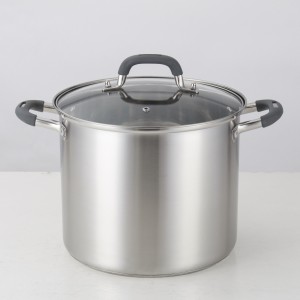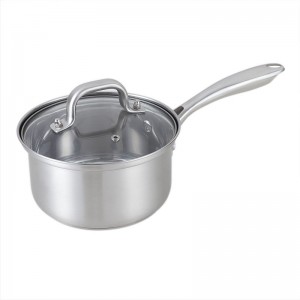What’s the difference between a stockpot and a saucepan?
A stockpot and saucepan are not interchangeable for most tasks. Stockpots are larger (more on that in a minute), and used primarily for simmering stocks, making large batches of stew, or handling specialty tasks, like boiling lobsters. On the other hand, a saucepan is small enough for everyday cooking tasks, and is meant for tasks like cooking grains and beans, making soup, and—of course—sauce.
Is a stockpot the same thing as a Dutch oven?
They’re similar in size, but not easily swapped. Dutch ovens are made from cast iron, either enameled or bare, whereas stockpots are constructed with steel or aluminum. Dutch ovens have excellent, even heat retention, which makes them ideal for searing meat, sautéeing, and baking bread. Dutch ovens are also generally oven-safe, whereas not all stockpots are (owing sometimes to the material used for the handles).
How big should a stockpot be?
Stockpots generally come in a few sizes, measured by the quart. For most home cooks, a 12-quart stockpot will be sufficient; they are also easier to stow away in cabinets. Bulkier, larger 16-quart stockpots are incredibly useful for large-format cooking, but if you only use it once a year or so, you’ll have to decide if it’s worth the extra storage space. If you only buy one stockpot, we recommend it be a 12-quart. If space is at a premium in your kitchen, and you rarely cook in large batches, an 8-quart may even suffice.
What are stockpots made of?
Most quality stockpots are made from stainless steel. We don’t recommend aluminum stockpots, as the metal can react with acidic foods. They also warp easily over time. Avoid enameled steel—the coating may help with browning, but it will eventually crack or chip.
What is cladding in a stockpot?
Cladding is the layering of metal in a stockpot. Typically, it’s aluminum surrounded by stainless steel. A pot that has full cladding on the bottom and sides will cook more efficiently and protect against scorching. It also carries a larger price tag.
What can I cook in a stockpot?
Stockpots aren’t the best choice for sautéeing, searing, and quick-cooking grains and beans. However, they really shine when put to work making stock and broth. Their large, generous size allows for big chunks of vegetables and bones or even multiple chicken carcasses. A quality stockpot will boil water quickly and keep it rolling for as long as you need, so it’s also helpful for blanching large amounts of vegetables or sealing jars (Think: canning and preserving season).
Do I need a stockpot?
That depends on how much space you have in your kitchen, and how often you plan on performing tasks that require a large-format pot. If you have the room to store it, we suggest investing in a 12-quart stockpot. You may not use it every day, but when you need its large capacity, you’ll be glad to have it on hand.
What can I use instead of a stockpot?
It’s hard to replace a stockpot just because of the sheer volume most stocks need. Larger Dutch ovens can sometimes due the trick, or a big saucepan, but those pots don’t have the capacity to hold as much as a stockpot.
Can you fry chicken in a stockpot?
The depth of most stockpots may make them seem like a good candidate for deep frying, but because most have thin walls, they have a harder time holding oil temperature steady than cast iron. While it is possible to deep fry food in any pot that’s deep enough, a Dutch oven is more preferred for its depth and heat retention. It’s also easier to retrieve food with a Dutch oven’s shorter walls.
Post time: Apr-25-2023






